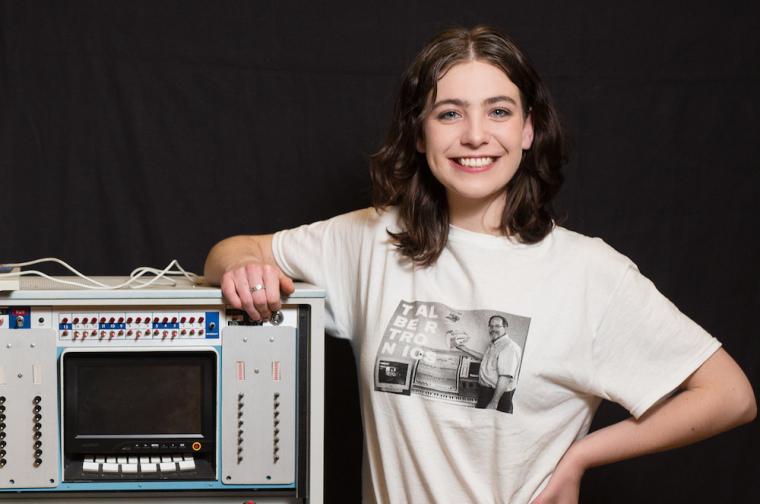Sounds of TIMARA...Today
April 3, 2017
Samantha Spaccasi

Photo credit: Tanya Rosen-Jones '97
Judy Jackson can’t pick her favorite part of Oberlin Conservatory’s TIMARA department. She loves everything about it.
“I’m 100 percent adamant that it’s the best major on campus,” she says. “It’s a really strong community with some really wonderful people. There’s a good exchange of ideas that happens within the department.”
Jackson is a fourth-year double-degree student from Minneapolis with majors in computer science and TIMARA, an acronym for Technology in Music and Related Arts. Though TIMARA became Jackson’s passion, it wasn’t always her intended path. “I started off as a composer,” she says. “I took composition lessons from my piano teacher starting at age 10.”
She began at Oberlin as a composition major, then took TECH 201 and TECH 202 and fell in love with TIMARA. Since then, she has dabbled in a little bit of everything the program has to offer. (In 2016, she even made an endearingly retro video of herself performing on the department's vintage Alles Machine, a repurposed research synthesizer donated to TIMARA by Bell Labs in 1980.)
“I do a lot of what’s called ‘mixed music,'” she says, referring to a type of music that combines acoustic composition with either live or fixed electronics.
In addition to incorporating mixed music into her live sets, she uses a synthesizer instrument that she built herself after being introduced to analog synthesis through the TECH 201 class. “I really liked the sounds they produced, but they’re not an economically viable thing for an undergrad to buy,” she says of the kinds of synthesizers she used in class.
The TIMARA department uses synthesizers like the ARP 2600, Putney, Buchla Music Easel, and the Pittsburgh modular. “The goal in building the instrument was to create something that produced the same interesting sounds, but that was cheap! I got to use my coding skills to produce an instrument that could stand up to these modular synthesizers. The burden of the cost was replaced by the burden of coding everything!”
Through her TIMARA studies, Jackson discovered “glitch audio”—what she calls “a nice intersection between computer science and TIMARA.” She was captivated by the process of putting together broken-sounding noises created from software like Max/MSP or Abelton Live. “I like glitch audio because it creates sounds that are unlike any digital synthesis technique I’ve ever come across—they have a richness and a complexity that provide a refreshing change from the standard techniques of granular synthesis and FFT manipulation.” But Jackson, not surprisingly, had no idea how those sounds were actually being made.
“The surprising thing about glitch audio is that there’s not much research on it,” says TIMARA professor Peter Swendsen, who encouraged Jackson to learn more. From there, Jackson applied for an Oberlin Flint Initiative Grant to support intensive research with a digital signaling processor researcher at NoTAM, the Norwegian Center for Technology in Music and the Arts, where Swendsen studied as a Fulbright Fellow.
Those winter-term studies, for Jackson, were followed by a three-week workshop at IRCAM—an institute in Paris dedicated to the science of avant-garde electronic music—as well as individual studies there. The workshop consisted of intensive study of Max/MSP.
Through her research, she has found that “the structure of files directly impacts how they will sound when they are read as audio files. There is a direct link between the byte content of a repeating sequence of code and the frequency and timbre of the sound it makes.” Jackson sees that glitch audio could be the next big step in digital audio. “The computer science behind it gives the composer absolute and extremely precise control of their sounds. You can literally build any sound you want from scratch using 1's and 0's.” She has also thought about how glitch audio can be useful for composers: "They can write data directly to files to create new and interesting sounds.”
Now Jackson is finishing her research and plans to publish a paper on her findings. Though she still has another year at Oberlin, she is considering applying for a research position at IRCAM. “That would be the dream,” she says.
You may also like…
Josh Nolan Named Vice President, General Counsel, and Secretary at Oberlin
Distinguished attorney brings extensive experience in higher education law.
Learning by Teaching: Oberlin Students Share Global Music with Young Learners
College and Conservatory students in PACE 103 prepare local children for an immersive community concert at Oberlin.
Nuiko Wadden ’02 Joins Oberlin Conservatory Faculty as Assistant Professor of Harp
The versatile musician brings extensive opera, orchestral, and contemporary music experience to her role


